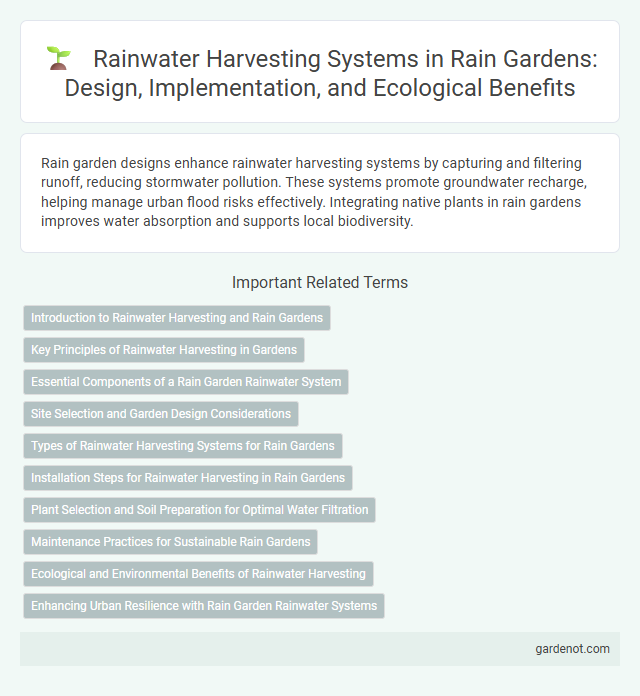Rain garden designs enhance rainwater harvesting systems by capturing and filtering runoff, reducing stormwater pollution. These systems promote groundwater recharge, helping manage urban flood risks effectively. Integrating native plants in rain gardens improves water absorption and supports local biodiversity.
Introduction to Rainwater Harvesting and Rain Gardens
Rainwater harvesting systems capture and store rainwater for reuse, reducing runoff and conserving water resources. Rain gardens are shallow, planted depressions that absorb and filter rainwater runoff from impervious surfaces, improving groundwater recharge and reducing pollution. Integrating rain gardens into rainwater harvesting systems enhances water management by promoting natural infiltration and supporting urban sustainability.
Key Principles of Rainwater Harvesting in Gardens
Rainwater harvesting in gardens relies on principles such as capturing runoff from impervious surfaces, storing the collected water in permeable basins or tanks, and promoting infiltration into the soil to replenish groundwater. Effective systems incorporate filtration techniques to remove debris and contaminants, ensuring water quality for plant irrigation. Implementing contouring and native vegetation enhances water retention and minimizes erosion, optimizing the sustainability of the rainwater harvesting system.
Essential Components of a Rain Garden Rainwater System
A rain garden rainwater harvesting system includes a few essential components such as an inflow area to direct stormwater, a permeable soil bed for natural filtration, and an overflow outlet to safely manage excess water. Native plants with deep root systems enhance water absorption and improve soil structure, while mulch layers reduce erosion and promote moisture retention. Properly designed rain gardens reduce runoff, improve water quality, and support local ecosystems by mimicking natural hydrologic processes.
Site Selection and Garden Design Considerations
Selecting a rain garden site requires assessing slope, soil permeability, and proximity to foundations to maximize water infiltration and prevent structural damage. Designing the garden involves choosing native plants tolerant to both wet and dry conditions, incorporating a flat-bottom basin with gently sloping sides to optimize drainage and water retention. Proper sizing, typically 20-30% of the impervious surface area draining into it, enhances rainwater capture and supports local groundwater recharge.
Types of Rainwater Harvesting Systems for Rain Gardens
Rainwater harvesting systems for rain gardens primarily include surface runoff collection, sub-surface infiltration, and storage tanks. Surface runoff collection captures water from rooftops or paved surfaces, directing it into the rain garden for natural filtration. Sub-surface infiltration involves permeable layers beneath the garden that absorb and filter rainwater, enhancing groundwater recharge and reducing urban runoff.
Installation Steps for Rainwater Harvesting in Rain Gardens
Installation steps for a rainwater harvesting system in rain gardens involve site assessment to identify optimal locations for water capture and infiltration. Excavation follows to create a basin that accommodates runoff, lined with permeable soil layers to enhance filtration. Finally, installing an inlet to channel rainwater from rooftops or paved areas into the garden ensures efficient water collection and maximizes groundwater recharge.
Plant Selection and Soil Preparation for Optimal Water Filtration
Selecting native, deep-rooted plants with high water absorption capacity enhances the efficiency of rainwater harvesting systems by promoting optimal water filtration. Soil preparation should involve amending with organic matter and ensuring proper porosity to maximize infiltration and reduce runoff. Integrating well-drained soils with diverse vegetation supports the natural purification of rainwater through biofiltration and microbial activity.
Maintenance Practices for Sustainable Rain Gardens
Regular inspection and removal of debris, sediment, and invasive plants ensure the optimal function of rainwater harvesting systems in rain gardens. Proper maintenance of inlet and outlet structures prevents clogging and water pooling, promoting sustained infiltration and groundwater recharge. Seasonal mulching and soil amendment enhance the absorption capacity, supporting long-term ecological benefits and reducing stormwater runoff.
Ecological and Environmental Benefits of Rainwater Harvesting
Rainwater harvesting systems significantly reduce stormwater runoff, decreasing erosion and minimizing pollutant loads entering natural waterways. By capturing and utilizing rainwater, these systems replenish groundwater supplies and reduce demand on municipal water sources, promoting sustainable water management. Enhanced biodiversity benefits arise as rain gardens create habitats for local flora and fauna, contributing to improved urban ecosystem health.
Enhancing Urban Resilience with Rain Garden Rainwater Systems
Rain garden rainwater harvesting systems play a crucial role in enhancing urban resilience by efficiently capturing and infiltrating stormwater runoff, reducing flood risks and mitigating urban heat island effects. These systems promote groundwater recharge and improve water quality by filtering pollutants naturally, supporting sustainable urban water management. Integrating rain gardens into city landscapes helps manage extreme weather events and supports climate adaptation strategies for resilient urban environments.
Rainwater harvesting system Infographic

 gardenot.com
gardenot.com